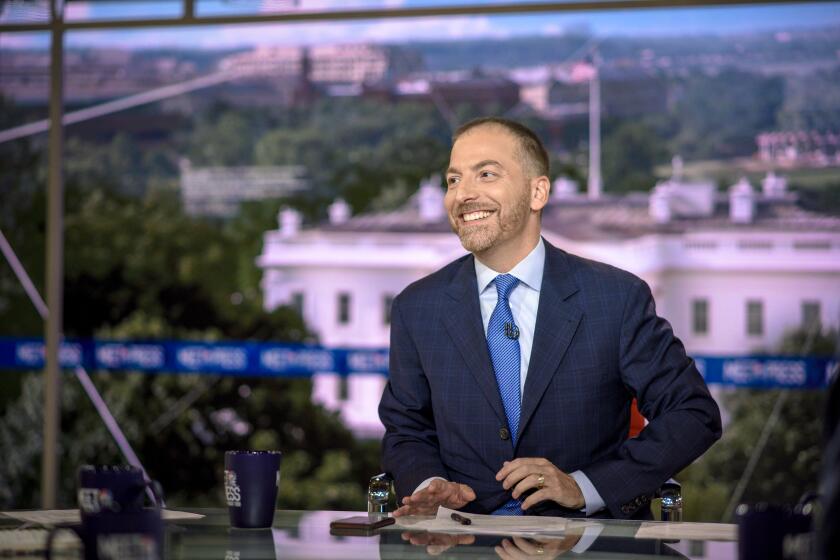Saving the Day : Using original charts, the Smithsonian jazz orchestra captures the spirit of legendary bandleaders and composers.
- Share via
Say “Smithsonian” and people immediately think of the Washington-based institution charged with the preservation of all things American. Covered wagons. Lindbergh’s airplane. Shaker furniture. Friendship 7.
Likewise, the Smithsonian Jazz Masterworks Orchestra, an offshoot of the Smithsonian’s National Museum of American History, is charged with the preservation of that uniquely American form of music called jazz. Since its founding in 1990, the orchestra has presented, mostly in the Washington area, a constantly expanding repertoire of music written by such great composers and bandleaders as Count Basie, Duke Ellington, Sy Oliver, Fletcher Henderson, Jimmie Lunceford and others.
This week, the 20-piece orchestra packed up it charts and instruments (its members are scattered around the U.S., most on the East Coast) and came West to Long Beach for three days of educational programs and clinics in Long Beach schools, the first in a series of Smithsonian Institution programs that will visit the city.
The highlight of the visit will be Friday’s concert at the Long Beach Convention and Entertainment Center. This will give fans a chance to hear the actual charts as written and played in the style of the day.
“Our mandate,” says David Baker, the orchestra’s conductor and artistic and musical director, “was to fill a need, to preserve styles of music that weren’t being played. . . . Music that isn’t played eventually becomes extinct. We’re here to play the music.”
*
The group used the Smithsonian’s Ellington sheet-music collection as a jumping-off point and branched out to include music from the ‘20s to the ‘40s.
“Recently, we’ve expanded even further,” Baker said, mentioning pieces such as Gil Evans-Miles Davis’ 1959 “Sketches of Spain” and the Gershwins’ “Porgy and Bess” from 1958. “By the year 2000, we’re looking to add pieces from George Russell, Bill Finegan, all very precious pieces of music that just aren’t done anymore.”
Sometimes, the orchestra’s re-creations are more true to form than those originally recorded in the ‘30s and ‘40s.
“Often the scores were thwarted by the limitations of the three-minute recording,” Baker said. “We’re able to restore the composer’s original intent as best we can determine it. Sometimes we do some smoothing over of the cuts but try to keep them authentic.
“If the piece was written by someone still alive, like Artie Shaw, we call them or someone from the band to find out their intent. If not, we just use our best judgment.”
*
Not only does the orchestra re-create the charts as written, but it has soloists who can play in the style of a band’s individuals. When Ellington is being played, saxophonist Loren Schoenberg makes like the late Johnny Hodges. Joe Wilder, a veteran of the swing era, can sound like Cab Calloway-era Dizzy Gillespie. When it’s a Benny Goodman chart, guitarist James Chirillo, a veteran of the Goodman band, plays like Goodman legend Charlie Christian.
But that doesn’t mean the orchestra’s performances are strictly museum pieces.
“Each of our soloists bring their own perceptions, their own personality, to the music. It’s not as if we’re playing in the fixed parameters of, oh say, Beethoven’s Fifth Symphony. In repertory music, we keep the structure, the wonderful template, but we keep its living quality that comes from improvisation.
“The one thing that characterizes our band is passion, a big passion about the importance of not forgetting where we came from. If jazz is going to continue to be strong and find a place in the culture, we need people who are not only creative and nurturing, but who also conserve and preserve. We bring a bit of both of those when we play.”
* The Smithsonian Jazz Masterworks Orchestra plays Friday at the Terrace Theater, Long Beach Convention and Entertainment Center, 300 E. Ocean Blvd., 8 p.m. $15-$20. Information: (562) 436-3661. Ticketmaster (714) 740-7878.
More to Read
The biggest entertainment stories
Get our big stories about Hollywood, film, television, music, arts, culture and more right in your inbox as soon as they publish.
You may occasionally receive promotional content from the Los Angeles Times.










